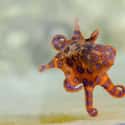-
(#15) Octopuses Have Hidden Beaks
Each octopus has a beak completely hidden inside its head. The beak is made of keratin, the same stuff that makes up human hair and fingernails. An octopus can not show its beak, but uses it to deliver venom to its prey and to crush crabs and mollusks.
Source: Distractify -
(#6) Octopus's Arms Even React When Severed
In some experiments, arms severed from an octopus's body jerked away when researches pinched them. This is because two-thirds of an octopus's neurons reside in its arms rather than in its brain.
Source: Smithsonian -
(#5) Octopuses Are Camouflage Experts
Octopuses are able to change the color of their entire body in three-tenths of a second. All cephalopods have skin that has three layers. The top outermost layer contains cells called chromatophores, which detect signals from underlying nerves and muscles and change color accordingly. Chromatophores contain red, orange, yellow, brown, and black pigments surrounded by muscles. The middle layer contains mirror-like cells called iridophores that instantaneously reflect the brightness of the animal's environment.
This is not thought to be conscious; in fact, cephalopods are believed to be colorblind! The bottom layer of skin contains white cells that provide contrast to the colors and patterns of the outer layers.
Source: Live Science
-
(#7) Male Octopuses Use Their Arms for Reproduction
The third right arm of a male octopus is special because it is his reproductive organ. In some species, this arm is visibly different from the others as it has fewer suckers. The modified arm, called the hectocotylus, holds rows of sperm called spermatophores. When mating, some species of male octopus insert the arm into a female's oviduct, while others just remove the arm and give it to her.
The female stores the arm in her mantle until she lays eggs, and then she spreads the spermatophores over the eggs herself.
Source: Mental Floss
-
(#12) There Are Over 300 Species of Octopuses
Today there are 300 different species of octopuses. The smallest is the Atlantic pygmy, whose arms are less than 4 inches long, and the largest is the seven-arm octopus, which has been recorded at 11 ft. long and weighing up to 165 lbs.
Source: Facts Legend -
(#20) Octopuses Are Very Fast Swimmers
Octopuses are able to jet themselves forward by expelling water through their mantles. This makes them incredibly fast swimmers.
Source: OneKind
New Random Displays Display All By Ranking
About This Tool
Octopuses are extremely complex, mysterious, and talented creatures with many hidden talents. These invertebrate but colorful marine animals have existed for thousands of years, making the ocean world interesting. They are masters of defense and able to disguise their entire body in seconds, due to the lack of a skeleton, they are very agile and can even grow their lost arms.
For centuries, their unique defense mechanism has fascinated biologists. Various octopuses are widely distributed in tropical and temperate waters around the world. The random tool introduced 21 fun facts about octopuses that most people may not know.
Our data comes from Ranker, If you want to participate in the ranking of items displayed on this page, please click here.
















